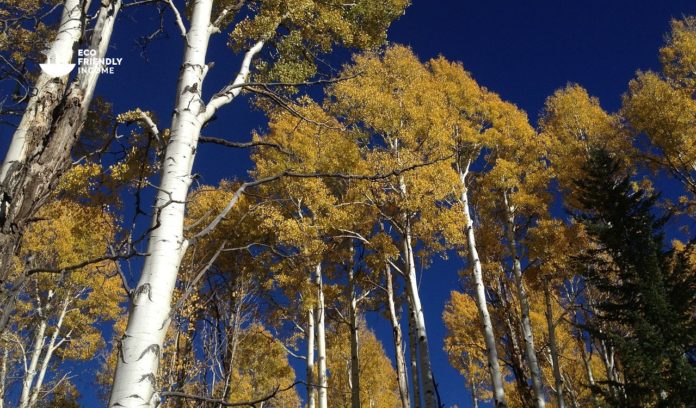This tree guide on Quaking Aspen (Populus tremuloides) is meant to provide all relevant information for tree nursery start-ups out there.

Hardiness Zone: 2 – 6

Soil Type: Acidic, loamy, moist, sandy, well-drained and clay soils.

Water: Normal. Prefers abundant moisture.

Exposure: Full Sun
Quaking Aspen (Populus tremuloides) is a species of deciduous trees native to cold regions in northern Canada. Other names are trembling aspen, trembling poplar, or white aspen. The tree’s cold hardiness allows it to survive the freezing temperatures of zone 2.
There are a few characteristics you can look at to identify quaking aspens:
How to Identify Quaking Aspen
Bark
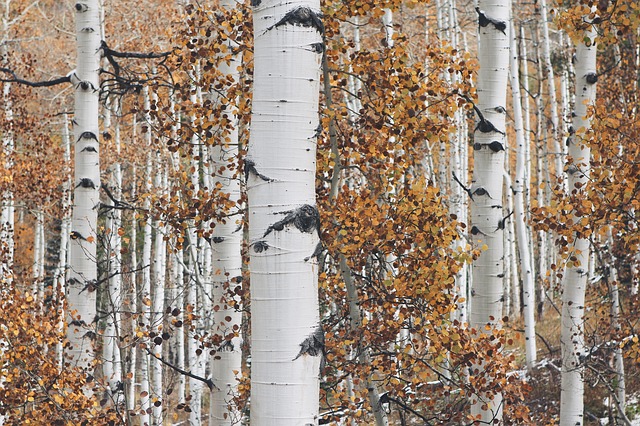
Quaking aspen is recognizable by its straight trunk and its smooth, light green bark.
As the trees grow larger, their bark turns grayish-white, and ‘eyes’ appear on their trunks where old branches used to be.
When you look closely, you’ll see horizontal lines on a quaking aspen’s bark. Those lines are called lenticels, they are what enables the gas exchange of CO2 and oxygen during bark photosynthesis
Leaves
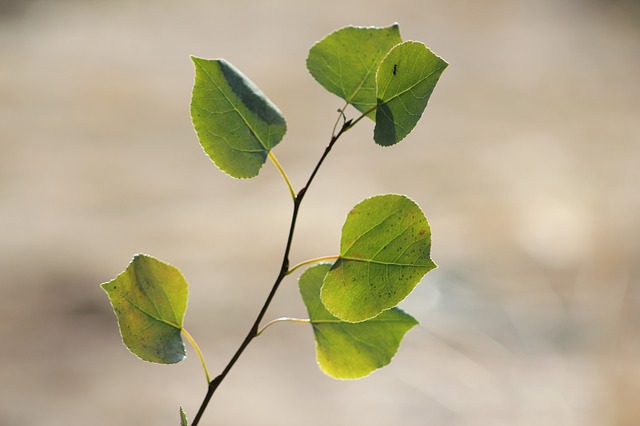
Quaking aspen leaves are simple, cordate to ovate-shaped with serrated edges and pointed tips.
They grow from 4-8cm in length and 3-6cm in width, in alternate arrangement along the branches.
The leaves are dark green above, paler underneath, and turn golden yellow, or red in the fall.
Flowers
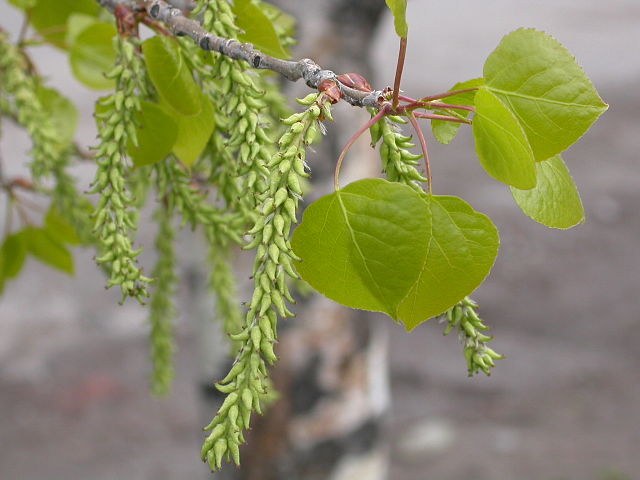
Distribution
Quaking aspen’s natural range is nearly all of North America, with exception of some southeastern states and Nunavut in the north.
They grow easily in all sorts of sites, but usually in lower altitudes. They can be found in the northern boreal forests, in all varieties of soils.
Their rhizomatous nature allows them to quickly repopulate areas disturbed by logging and wildfire.
It’s common to see quaking aspen growing in groves, that’s because a few individuals can spread out in a large area with their underground roots.
Ecology

Aspens are a self-perpetuating sort of tree that doesn’t rely much on wildfire for reproduction but does benefit from them in the long term.
Aspen tree stands are not always the climax of a community, oftentimes, they get replaced by species of conifers. Fires in this case become a boon for aspen tree stands, which don’t burn as easily.
When a wildfire goes through an area once populated by aspens but now taken over by conifers, a new chance is given. The dead conifer trees open up the area once again for the underground root system of the aspens to take over.
This is why areas that were once affected by wildfire have communities of aspen trees about the same age that all sprouted at once.
It is possible though to have a self-perpetuating colony of aspen without risk of conifer invasion. In this case, it takes a few factors like uneven age structure, absence of shade tolerating trees, and lack of successional change.
In this situation, older aspen trees fall over to be replaced by shoots coming from the same root system, in an endless cycle.
Genetics
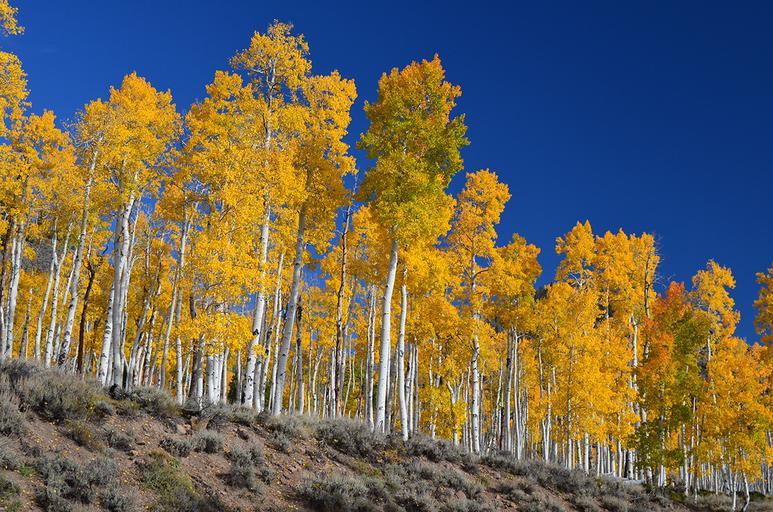
Aspen trees reproduce readily by suckering growth, which happens when the rhizomatous root system spreads far and sprouts new clones.
The sprouts are genetically identical to the parent tree because they simply come from the same root system. They carry the same DNA.
Which means trees you see in an entire aspen stand can be genetically identical.
These clonal root systems usually spread far and wide, up to many acres in size.
Pando, in the Fishlake National Forest in Utah, is a giant quaking aspen grove that has lived quietly for the past 80,000 years. It’s possibly the world’s oldest living organism.
Clonal colonies are not something unique to quaking aspens tough, other species can also do this. Other common clonal species are willows, Canada goldenrod, blackberry, and raspberry.
Disease & Pest
Since quaking aspen colonies have a strong underground root system, the colonies are pretty disease resistant. The trees themselves though are more vulnerable and can become infected with a few diseases.
The following are the most common diseases that affect quaking aspens:
Hypoxylon Canker
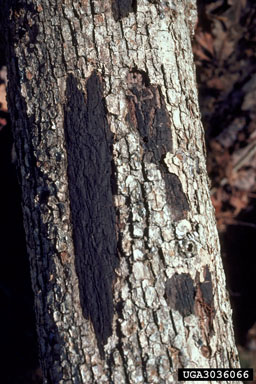
Hypoxylon canker is caused by the fungus Entoleuca mammata which affects the bark of quaking aspen trees.
The fungus often catches hold of the tree at the branch unions, in stubs, wounds, or galls. The disease causes the bark change color, blisters then appear, and eventually the bark bursts open.
Grayish-black bumps are the fruiting body of the fungus and spread fungal spores.
It survives from season to season and can kill a tree within 3-8 years. There’s no fungicide you can use to save your trees if they are affected by it.
The best way to manage hypoxylon canker is to prune the infected limbs or cut down the affected trees.
Heartrot
It’s a fungus called Phellinus tremulae that spreads inside the heartwood of weakened aspen trees. As the name suggests, it rots the heartwood and prevents the trees from disposing of its waste, which normally gets deposited in the heartwood.
Trees affected by this disease often get knocked over by strong windstorms.
Quaking aspen diseased with heartwood makes them the perfect host for a variety of other insects.
Cytospora Canker
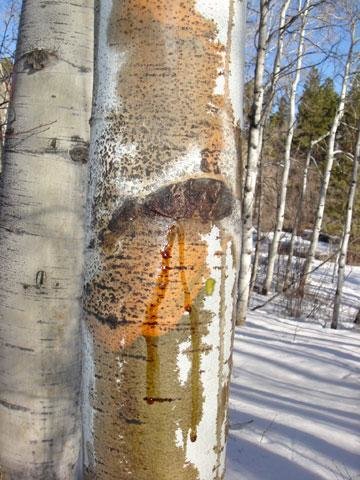
This fungal disease causes an aspen tree’s bark to turn into a brownish-orange color.
Cytospora cankers can appear bot on the trunk and the branches.
You can often see a sticky liquid dripping down the bark of the infected trees. The cankers spawn as black indented spots, or pimples that produce more fungi.
Additionally, when humidity levels are high, the cankers or pimples produce large threads of orange fungi that can be visible with closer inspection.
You could possibly remove small trunk cankers if you remove the infected tissue down to sound, un-stained wood. With infected branches, you want to remove them with sterile pruning sheers.
Aphids
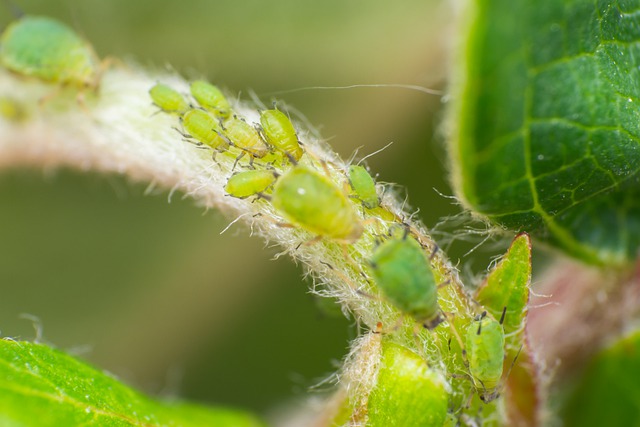
Aphids are small sap-sucking insects that feed on a variety of plants, quaking aspens being one of them.
Usually, they aren’t much of a problem because of their predators, the ladybugs. But in some instances when ladybugs are abscent, aphids can spread and infect a tree.
You can recognize aphid damage by looking at the leaves, which will usually curl on themselves.
To treat this problem, the use of eco-friendly pest control is possible.
Aspen Leafminer
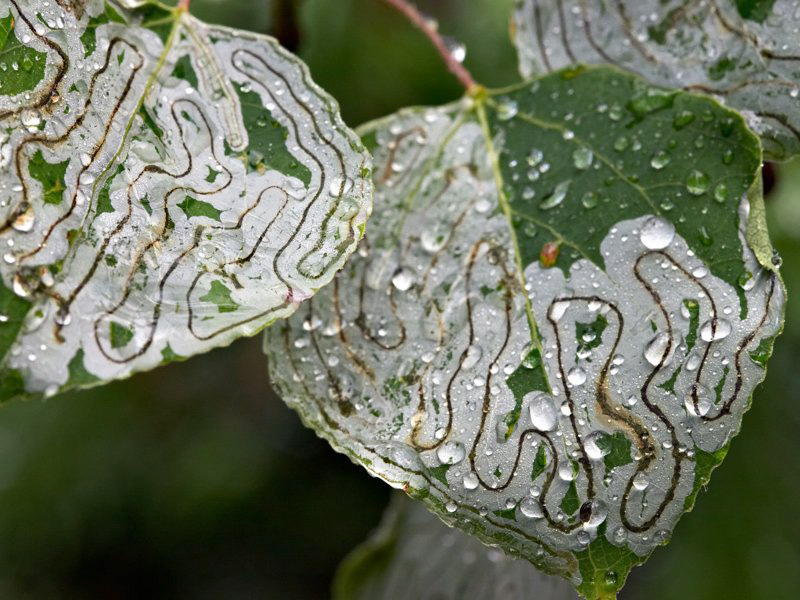
Aspen leafminers (Phyllocnistis populiella) are a type of caterpillars that use aspen leaves as hosts. The adult moths lay their eggs on the leaves, then turn them over for protection.
When the larva hatches, it burrows itself into the leaves and eats away at the interior tissues of the leaf.
Not much can be done against leafminers other than pruning your infested trees. Natural predators and colder seasons contribute to the crash of leafminer populations.
Other common insect pests that affect quaking aspens are spider mites, oystershell scales, ad poplar borers.
Uses
Quaking aspen trees have both commercial and environmental uses.
Environmentally
- They are a keystone species that sustain the existence of a great number of plants and animals.
- Aspen tree groves are a great contributor to soil carbon sequestration.
- They survive and bounce back quickly from wildfires
Commercially
- They are important for livestock and wildlife forage.
- Quaking aspen trees work well for commercial revegetation.
- Aspen groves improve esthetics for tourism.
- Lumber maybe not be prized, but the trees grow rapidly and wood can still be used as a laminated veneer, amongst other things.
Dieback
Aspen trees are the most abundant and widely distributed tree in North America. But lately, something has been observed with them: dieback.
We’re seeing rapid deaths of many clonal trees, and what it’s doing is breaking up the big aspen stands into smaller ones. This is leaving place for other species to move in and take over aspen territory.
We’re not exactly sure what’s causing this but there are a few factors that have a correlation:
- Drought: Trees lose their ability to produce and store food.
- Pests: Insects are defoliating trees, preventing them from properly transforming carbon.
- Browsing: Wild animals or farmer’s stock browse the new suckering growth and leave few trees for regeneration.
- Freezing Events: Climate change is causing more eratic weather events, warm periods followed by a period of frost damage trees.
So far, the aspen dieback seems to be happening more in the regions of western Canada & the United States.
How to Know if Your Aspen Grove is Healthy
There are a few characteristics you can look at to know if your aspen grove is healthy or not:
Look at the forest floor, and inspect what you see. Are there multiple generations of aspen trees? By that, I mean seedlings, semi-mature trees, and large mother trees.
A healthy aspen grove should be hard to see through. It should be thick and visually show all the generations of aspen trees.
If you see that your aspen grove has mature trees but the understory is dominated by conifers, tall grasses, and shrubs, that means the replacement of aspen is underway.
That tends to happen in the absence of natural disturbances like forest fires. The understory plants choke the aspen seedlings of sunlight and disrupt the multi-generational cycle.
The key indicator to know if your aspen grove is healthy is the presence of new undisturbed sprouts.
How You Can Propagate Quaking Aspen
If you wish to cultivate and propagate quaking aspen yourself, you have two options.
You could grow them from seed, or from root cuttings.
- Seed: Involves harvesting their tiny seeds in the spring.
- Root cuttings: Involves digging and seperating a part of the rhizome.
Propagate by Seeds

The best time to collect aspen seeds from the catkins is from about early June to mid-July.
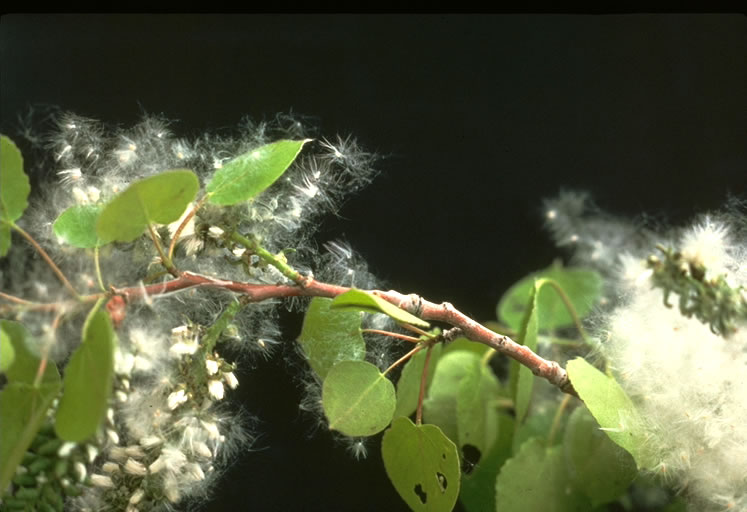
You want to get to the catkins just before they open because when they do, the fluffy seeds easily get picked up by the wind.
When you collect the catkins, just place them in brown paper bags to dry.
From there, what I suggest to do is to take a wet paper towel and pick up the seeds with it.
To germinate you can lay the wet paper towel down on topsoil and cover it with a fine layer of soil.
Aspen seeds have short viability so it is recommended to sow as soon as possible.
They require no winter dormancy.
Propagate By Root Cutting
You can also propagate quaking aspen by taking root cuttings from their strong rhizomes. Here again, timing is key:

Root cuttings need to be harvested in early spring for best success.
Here’s how to do it:
- Find a young, healthy aspen tree and observe its surroundings.
- You might see shoots coming out of the ground nearby, that means the tree has got extensive rhizomes underground.
- Now dig around one of those shoots, you’ll see its root system but you’ll also see a big root leading up to it.
- That big root is the rhizome, what you want to use to make cuttings.
- Follow the rhizome and dig as far as you want for cuttings. Cut what you need and split them into long strands, from 15cm to 1m.
Long root cuttings are fine because you’ll be taking the new suckers that come out of them. Long, thick cuttings will generally have a better potential but one should not get carried away and extensively damage the mother tree’s root system.
From there, put the cuttings in a box with peat soil, then cover the root cuttings with compost/leaf mulch mix.
Keep it moist and wait, you will see suckers come out.
You have two options with these:
- You can wait for them to form semi-hard wood, then cut them off from the rhizomes. In this case, you dip them in rooting hormone and place them in covered propagation boxes. They will root individually that way, in sandy soil preferably, within 4 weeks.
- You can leave them attached to the root cutting and see if they will produce roots from there. It’s not guaranteed but naturally that’s how they do it. Giving them proper lighting, and warmth might increase success.
Seems like quaking aspens generally propagate better without the intervention of humans. But hey with enough persistence, you might get really good at propagating aspens and become the herder of new aspen groves.
Quaking aspens are one of my favorite trees, and if I can somehow help anyone grow them, that’s a really fulfilling effort to me.
May you also be prosperous in your efforts to propagate quaking aspen trees!
Do you have any tips and experience to share? Please leave a comment down below and share it with the community.

